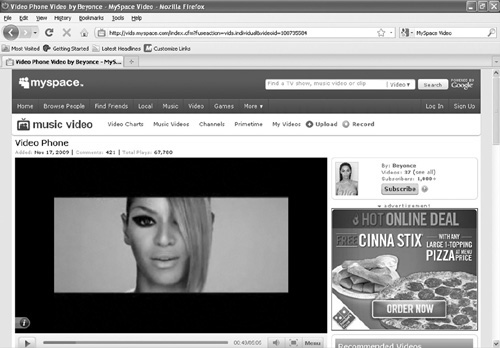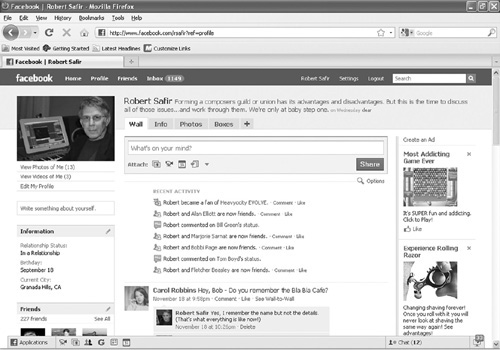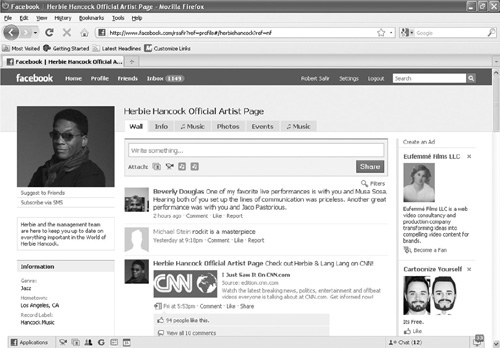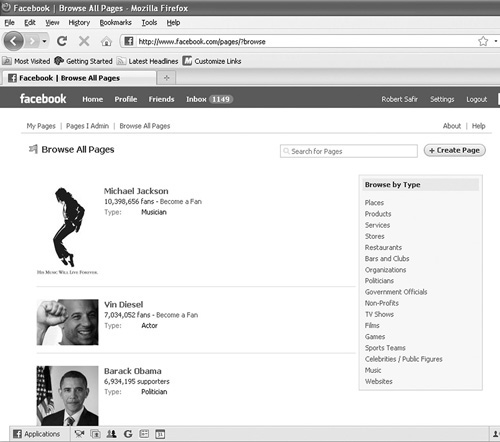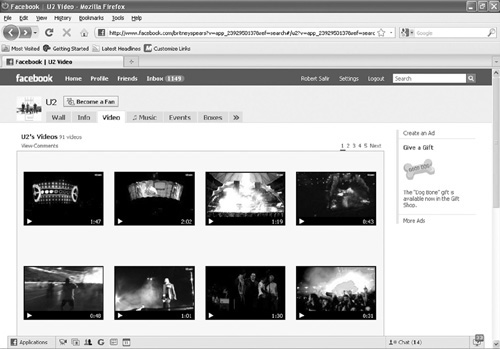THE EFFECTS OF THE INTERNET and digital media on our lives have been so profound that it’s difficult to summarize it in a sentence, a paragraph, or a book. That’s partly because we are in the eye of this storm of change. The Internet has changed the way we communicate, the way we create, the way we educate, and the way we entertain. One thing is certain—the Internet has forever changed the music business, from the creative process to the way we market new music to others. This book has thus far dealt with the former, and now it is time to address the latter.
This chapter includes a discussion of traditional marketing and social marketing. There are some who believe the newer social marketing, which includes leveraging sites such as MySpace, Facebook, Twitter, and a whole lot more, are not only the wave of the future, but also simultaneously relegate traditional marketing to the distant past. And there are others, including this author, who believe that a combination of traditional and social marketing is the best formula for success.
One thing I’ve learned over the years is that it’s tempting to throw the proverbial baby out with the bathwater. I was working for Microsoft when CD-ROMs first debuted and everyone hailed the end of printed books. Obviously, that didn’t happen, and the two media have coexisted for many years, each having its own distinct advantages.
Now, if someone were really brilliant back in the day, they would have known that CD-ROMs weren’t the threat—the Internet and portable devices were the threat. Of course, that was a long time ago, and no one could see it coming. Likewise, we can’t be certain what the marketing process will really look like 20 years from now. And so, because I believe in a combination of traditional and social marketing, I offer you information on both methods and how they can be used together.
The answer, in a word, is no—not necessarily. (Yes, I know, that’s three words.) The saying has many variations based on the original—“If you make it, will they come?” The “it” might refer to any type of product from software to computer hardware to a new type of toaster. The phrase is often heard in the halls of marketing departments where product managers and product developers are in heated debates about the chances of their product’s success. The old school of thought states that if a product is good enough, people obviously will buy it. The newer school states that unless some significant marketing energy is put behind a product (or service, for that matter), the chances of success are very limited, no matter how good the product actually is.
I suggest that marketing effort is not a luxury but a necessity in the music business, and that certainly applies to getting your music video seen and heard.
The good news is that the Internet has changed all the rules. Now, instead of a few select artists being lucky enough to have a record contract, the playing field is wide open. With the Internet, it is now possible for one act to be marketed to millions of people, record label not required. Sure, small independent labels may be effective in this new arena, but the days of major corporations being a necessary part of the record-making machine seem to be pretty much over.
The bad news is everything I just wrote in the preceding paragraph. Because the playing field is wide open, the Internet is flooded with acts of all kinds and all levels of experience vying for the attention of those millions of prospective listeners. Maybe it’s true that major labels are a thing of the past, but those same labels acted as a filter of sorts so that some level of quality and professionalism was present in the artists who made it to the surface. The often-used distribution models of one-to-many or many-to-one can be applied to the way music industry distribution has changed over the years, as shown in Figure 13.1. The old record industry allowed a few artists to reach many people. The current digital music industry has an overabundance of artists, but they’re able to reach only smaller portions of the audience. The ideal of the future would be many artists having the ability to reach many people.
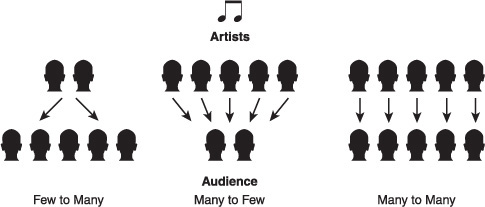
Figure 13.1. From left to right, the first diagram represents the “old” model of music distribution, the second is the current digital music distribution, and on the right is the hopeful future.
All of this is to say that marketing now plays a more significant role—not that it didn’t have an important role before—but perhaps now, more than ever, a strategic marketing mix has become a necessity, especially in light of new marketing methods.
The marketing mix has traditionally consisted of “The Four Ps”—Product (or service), Place, Price, and Promotion. Simply put, it means putting out the right product at the right time and place and at the right price point. These Four Ps correspond to the formal definition of the marketing mix (see Figure 13.2).

Figure 13.2. A classic definition of the marketing mix describes marketing strategy in terms of “The Four Ps.”
There are other definitions of the marketing mix as well. From a tactical point of few, it can be considered as a combination of different marketing methods and techniques. It can be your marketing communications strategy, directing your message to your prospective customer (or fan) from all sides. Some have called this approach 360 degree marketing, although you can find dozens of other versions of what 360 degree marketing is supposed to mean. Figure 13.3 represents just one of them.
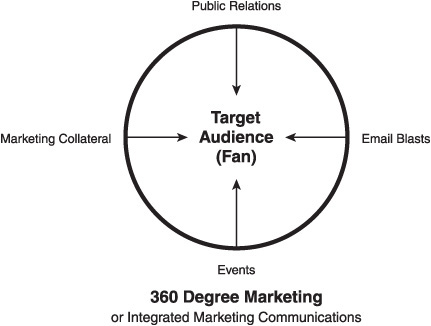
Figure 13.3. This is one of the models of the term “360 degree marketing,” combining different marketing techniques to reach your target audience.
For the purposes of this book, I’m going to look at the marketing mix through a contemporary lens. I will view traditional marketing as all of the “old school” marketing methods, from positioning to PR to promotion. Social marketing will include such phenomena as MySpace, Facebook, Twitter, blogs, forums, and the like.
Somewhere between traditional and social marketing there was the practice of viral marketing or guerilla marketing, mostly utilizing websites and email as marketing tools. This was before social marketing and serves as a good example of a transition period between the old and the new marketing methods. These concepts are illustrated in Figure 13.4.
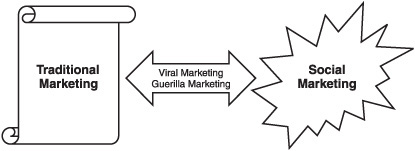
Figure 13.4. An illustration of traditional marketing, social marketing, and the transition that occurred between the two.
Now, take a look at traditional marketing and social marketing and see if it doesn’t make sense to create a formula for an even newer marketing mix. This mix might consist of a combination of traditional marketing, viral marketing, email marketing, social network marketing, and more—but likely will involve some of each.
A discussion of the fine details of every marketing tactic you can use, whether traditional, social, or a mix of both, is beyond the scope of this book. At a higher level is the need to have an understanding of marketing concepts. Once you understand those, you can determine which ones apply to you and then use your creativity to create a marketing plan of your own.
Traditional marketing is the marketing we and our parents and their parents grew up with. According to the American Marketing Association, it is “the process for creating, communicating, delivering, and exchanging offerings that have value for customers, clients, partners, and society at large.” If that sounds a bit corporate, that’s because it is. Several of the processes that comprise traditional marketing might apply to large businesses and corporations, whereas others have validity for us, the makers of music videos. Traditional marketing in a company usually includes activities such as developing a mission statement, positioning, market segmentation, value proposition, branding, public relations or publicity, promotion, and advertising. Sounds like this is the corporate stuff, right? Well, not necessarily—not when you understand how these things may apply an individual level.
A mission statement accurately describes why a company or organization exists and what it hopes to accomplish in the future. It’s a description of its purpose—its reason for being. Mission statements can sometimes be a mouthful because marketers want to make sure that everything about the company is summarized in one paragraph. Sometimes the statement is full of jargon, but here’s an example of a simple one from The Coca-Cola Company:

The Coca-Cola Promise: The Coca-Cola Company exists to benefit and refresh everyone it touches. The basic proposition of our business is simple, solid, and timeless. When we bring refreshment, value, joy, and fun to our stakeholders, then we successfully nurture and protect our brands, particularly Coca-Cola. That is the key to fulfilling our ultimate obligation to provide consistently attractive returns to the owners of our business.

Sometimes a company’s mission statement is summarized in one line. For example, the mission statement of Starbuck’s Coffee is “To inspire and nurture the human spirit—one person, one cup, and one neighborhood at a time.”
Now, how does a mission statement apply to you? On an individual level, your mission statement might be as follows: “My mission is to grow personally, professionally, and emotionally by using my unique perspective and my belief in others’ inherent goodness and integrity.” Sounds simple, but to do this daily and on a consistent basis might be difficult. That’s what mission statements are for—they remind us why we do what we do so that we stay focused on our main objective.
An artist can have a mission statement. A band can have a mission statement—perhaps something like this:
Our mission is to provide life-long entertainment experiences for our community, country, and planet, through the performance of original music, music videos, and live concerts. In the course of achieving our goals, we will be an example of good teamwork and friendship, resolving any internal disputes or obstacles that might get in our way. While competing at the highest level in the entertainment industry, we will provide opportunities for others to share our experience whether they are a fan or a part of our extended team.
A business or enterprise usually publishes its mission statement in its marketing literature and on its website. You, as an artist or a band, do not have to publish a mission statement. But its true value is that it can keep you focused on your goal, remind you of why you do what you do, and increase your chances of success. You don’t have to publish it to the world, but you can certainly integrate it into your thinking.
Positioning is the process by which you create an image or perception in the mind of your customers. It often includes competitive positioning—how your product or service is better than the competition. When I was involved with marketing high-tech products for companies such as Microsoft, Digidesign, and Cisco Systems, the subject of positioning came up almost on a daily basis. Al Ries, sometimes co-writing with Jack Trout, wrote an excellent series of books on marketing, one of them called Positioning: the Battle for Your Mind. Another personal favorite of mine by these two authors was (and is) The 22 Immutable Laws of Marketing. If you want only one book on traditional marketing techniques, The 22 Immutable Laws of Marketing (shown in Figure 13.5) is your best bet.
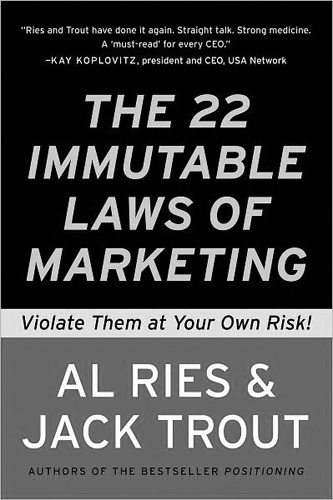
Figure 13.5. This book, by Al Ries and Jack Trout, gets my highest recommendation for understanding traditional marketing principles.
When you position a product, you define the competitive landscape in which you will compete, collect a sampling from existing customers on their perceptions of similar products in that “space,” estimate the mindshare that the competitive products currently have (and how they are positioning in that space), and finally you position your product.
Your product is you or your band. Using positioning, your goal is to establish a perception of your artistry in your target market, namely, the minds of your fans. To understand who your fans are and what makes them tick, you can use a process called market segmentation.
The process of market segmentation enables you to focus on the precise category of prospective customers (read fans) that is most likely to purchase your offering. For large companies, this might mean dividing up the target market by size, age, sex, business function, and job responsibility. Once these qualities are defined within the target market, it’s easier to zero in on the prospective customers’ needs.
Perhaps the needs of your customer (music fans) are fairly straightforward—music may satisfy an emotional need that simply enhances their pleasure. The audience for music— that is, the mass market—is huge. With target marketing, you define your specific market’s needs without trying to be all things to all people. What satisfies one customer, perhaps heavy metal music, might be completely inappropriate for another who likes smooth jazz. And as you know from Chapter 6, “Choosing a Video Style,” on the topic of heavy metal music, that category can be further broken into many subcategories.
Your job is to know where you fall in the scheme of things and what kind of characteristics you will find in your prospective customers or fans. A lot of this occurs naturally (without requiring a lot of market research) because the qualities of your act—your music, your appearance, your message—all appeal to a specific audience in the first place. You reach your audience because you are putting forth your particular brand. If you or someone in your band is more of the analytical type, then doing some exercises in market segmentation may be worth your while.
Your exercises in positioning and market segmentation contribute to your understanding of your brand. Your brand is your identity—how you want your fans to perceive you. The degree of your success will make your brand range from unknown to a “brand name.”
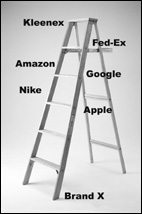
Naturally, everyone wants to become a brand name, a name so recognizable that no explanation is necessary to understand what that brand name represents. Examples of this are Kleenex, Fed-Ex, Amazon, Google, and The Beatles. You may not be the next Beatles, but you will want to get as high as possible on the branding ladder.
A brand might be a combination of characteristics, some of them innate, such as your body’s physical appearance, and some of them created, such how you clothe that body. Often a brand has components that are intangible. And more than likely, a brand is greater than the sum of its (tangible and intangible) parts.
Have you ever seen a commercial that has absolutely nothing to do with the actual product or company? The brand is so successful that it represents a larger feeling. The brand message can be communicated without showing the product. Think Nike or Apple. There are some brands that are so strong that their (perceived) importance is much, much larger than the actual product, service, or company.
There may be more than you think when it comes to understanding the branding process, including concepts such as brand recognition, brand equity, brand franchise, and brand extension, to name a few. You can certainly succeed without this knowledge, but in a very competitive marketplace, the more you know, the better.
The value proposition is one of the most corporate-sounding terms in marketing, and you may have a harder time relating to this term than to some of the others. Simply put, the value proposition is the statement of the sum total of benefits that your customers get for their money and/or time.
By the widest definition, you are likely to say that you provide customers with excellent entertainment. But other definitions are possible. Perhaps your band is active politically, so you provide political awareness. Perhaps your music makes people relax or brings people together in a social network. Knowing your value proposition is directly related to your positioning and, further, can make you stand out against your competition.
But most artists, let alone people in general, rarely think about this. Perhaps many people have internalized some form of a value proposition a long time ago and feel they don’t need to revisit it. However, revisiting it from time to time can ensure that it reflects your value proposition as it stands today and, at the very least, brings your value proposition back into your consciousness.
One of the best ways to zero in on your specific value proposition is to see yourself from the outside. Pretend to be a potential fan at a concert looking up at the band on the stage and trying to imagine how they see you and why you stand out from other artists. If you can define your value proposition, you can broadcast that message—overly or subconsciously— to your ever-increasing audience.
PR is the “spin machine.” PR (public relations) is the term most often used in the business or corporate world. Publicity is similar to PR, but is the term more common in the entertainment business. Promotion is, well, promotion. Promotion activities are activities such as trade shows, endorsements, sponsorships, and direct mail campaigns.
Although promotion may sometimes involve cash outlay, most PR activities are the type that can be executed for little or no money. If a magazine publishes a story about you as an artist, that’s PR. The type of visibility that a magazine article can give you is arguably much better than if you were to take out a full-page ad in the same magazine. Indeed, this is an argument often made in debates regarding marketing budgets. Advertising is very expensive, so when budgets are tight, marketing managers (especially the ones higher up on the corporate ladder) prefer getting some free publicity to paying for full-page, four-color ads.
Some types of PR are more believable than others. One example is sponsorships. If Taylor Guitars sponsors you as an artist, people will probably think you must be a very talented performer. If they name a guitar after you and your name happens to be Taylor Swift, you probably don’t need the extra publicity, but it certainly doesn’t hurt! Take a look at the Taylor Guitars homepage in Figure 13.6.
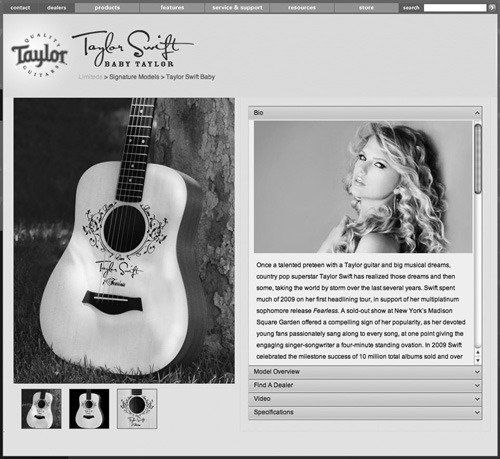
Figure 13.6. You’re doing well if you are sponsored by a company such as Taylor Guitars. It’s even sweeter if one of their guitar lines has your namesake on it.
The most elementary form of PR is the press release. You have probably seen press releases before, and they all follow a specific format (as indicated in the upcoming sidebar).
Press releases are written in third person, as if you were a reporter writing about the subject of the press release. In other words, you would never say, “I released my new album today.” Instead, you would write, “Peter Piper released his new album today.” When sending out a press release, the first thing to ask yourself is whether you really have some news. There’s nothing worse than a press release that has nothing important to say. There should be some sort of story, whether it’s simple, such as your new album release, or more complex, such as your new music licensing website that serves the film, television, and Internet industries.
The press release is a delicate balance between spin and fact; it’s not just one or the other, but a bit of both. If the press release is written as straight spin, it will come off as hype. If it is written as pure fact, it will come off as dull. You need just enough spin to make the announcement in the press release seem exciting, as well as enough facts to substantiate your claims.
You can distribute your press release to your contacts via email. Most professionals use a press release wire service such as PR Newswire, Business Wire, or WebWire. These services do cost money, but they have a prepared list of important press contacts organized into very specific markets. You may want to research these services a bit more to see if they are something you need.
Advertising is a means of getting your message out to persuade people to do something, whether it means buying your latest album or thinking that you’re the best artist to come along in a century. (Be careful of that last one—advertising gives you more leeway than PR, but you still have to have your feet planted somewhere on the ground.)
Traditional advertising has relied on traditional media, including print (magazines, newspapers) broadcast television, cable television, radio, and, of course, the Internet. Advertising has grown to include any conceivable form of delivery and can now be found anywhere, from cereal boxes to sides of buses to bathroom stalls. (I didn’t want to include that last one, but it demonstrates that there is no limit to what advertisers will do.)
Advertising is not cheap. A small newspaper ad can cost several thousand dollars. A television ad in prime time can cost up to $200,000, and if the commercial is run during the Super Bowl—well, I won’t go there. Because advertising is expensive, it is important to measure its effectiveness. Companies have achieved this through specific telephone numbers related to a promotion or by having consumers ask about a very specific promotion. The big word here is metrics—that is, applying some form of measurement to the results of your advertising campaign.
Advertising in an environment such as the music business has its challenges, and never before have those challenges been as extreme as today. Because the business is undergoing such radical change, mostly as a result of the digital age and the Internet, the old forms of advertising are not as effective as they used to be. It is difficult to have a successful ad campaign in a magazine if the magazine itself is struggling for survival.
Like traditional advertising, traditional marketing has one foot in the past and a few toes in the future. The future may have more promise through social marketing, or as I stated earlier, some combination of both. So, it’s time to take a close-up look at social marketing.
If you were to run a search on social marketing via Google or any other search engine, the first few hits might surprise you. Some of the definitions that are cited resemble the description, almost to the letter, of the traditional marketing mix. Another site defines social marketing as the use of marketing principles that are for the greater good of society, rather than for the profits of a corporation. There are a lot more and varying definitions. Naturally, they are not the type of social marketing I’m talking about here.
Note
Technically, it might be more accurate to say social media marketing, which, among other things, uses different Internet marketing sites such as Facebook, Twitter, and MySpace as a means to reach one’s target audience. The entire phenomenon of social media marketing, from blogging to tweeting, is sometimes grouped under the general heading of Web 2.0. For the purposes of this chapter, I use social marketing or social media marketing interchangeably, and I always be using it to mean the Web 2.0 phenomenon.
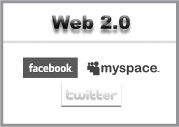
Social media marketing is a much newer phenomenon than traditional marketing or even viral and guerrilla marketing. I have found that the latest, greatest thing is often overhyped when it first emerges. It remains to be seen whether social media marketing falls into the overhyped category. Time usually tells the difference, and there hasn’t been enough time yet to know for certain. Thus, my discussion of social media marketing comes with a cautionary message to use these new marketing tactics with moderation, unless of course, you are creating such a buzz that your ears won’t stop ringing. In that case, keep doing what you’re doing, without restraint.
One of the first incarnations of social media marketing occurred when there was no such term as social media marketing. Blogs (a contraction of the words web and log), originally were simple logs or diaries that an individual posted on the Internet. Soon blogs also became a means of creating one’s own editorial space by focusing on a particular topic and making regular entries, reporting an event or supporting an idea.
If a blog could be authored by an individual, why not have a blog authored by an individual from a particular company? Well, that’s precisely what came next, with many executives, including company CEOs, writing their own blogs. The company blog accomplished several goals. It allowed a company to get its message out. The blog provided a means of creating buzz. It also created a new way to gain insight into a company’s customers—to find out what they really think about a brand or a product.
All of these benefits apply to individuals as well, including the makers of music videos. Bands can have blogs; artists can have blogs. A band’s blog may have reports from its concert tour; an artist’s blog may have updates on how the latest studio recording sessions are progressing. A blog can, in short, have anything you want in it.
But the term “content is king,” although overused, still has validity. Just because you can blog about something doesn’t mean you should blog about it. Like other content, it needs to gain a reader’s attention, have a story of some significance, and provide a reason for the readers to follow the blog.
What’s the difference between a blog and a website? If you were to suppose a blog and a website have identical content, the difference is shown in the real-time experience of a blog. A blog is more immediate, timelier, and generally speaking more recent than a static website. A website needs to pull readers in. A blog pushes its contents out.
With all that in mind, it’s also interesting to note that a blog can be a part of a website or a part of a MySpace page. Or it can live on its own as a blog hosted by a site specializing in blogs, such as WordPress or Blogger.com (shown in Figure 13.7).
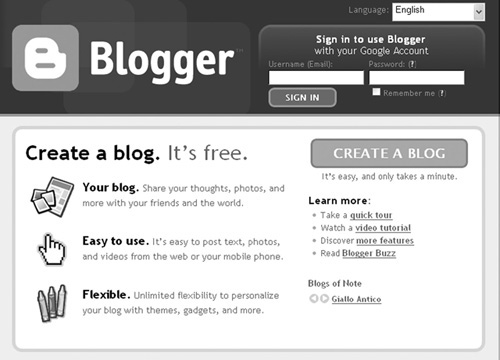
Figure 13.7. A blog can be a part of your website or one of your social networks, or it can be on a dedicated blogging site such as Blogger.com.
An individual may blog to keep in touch with friends and relatives. A company may blog to understand and influence its customers. An artist or band may blog to increase its fan base.
Blogging is good. I highly recommend it.
MySpace has been known for a long time as the place to go for social networking. It became a huge destination for people of all types—at first, young people looking for other young people with a desire to make friends; then professionals from all walks of life who wanted to network, promote themselves, and make friends; and ultimately, everybody and anybody had a MySpace page.
Before MySpace, anyone who wanted to create their own individual websites needed some computer programming experience. MySpace made it easy to have a “page.” All you had to do was sign up.
It wasn’t long until a prevalence of musicians, bands, artists, and singers seemed to dominate the MySpace population. You can sign up as an artist/musician and have your own space to upload your original music, play it, sell it, announce your touring schedule, create a blog, and in every way, shape, and form promote yourself until the cows come home. And perhaps most important of all, you can upload ten of your own original tracks for people to listen to or download. In Figure 13.8, you can see my main MySpace page with the music player on the right.
The naysayers would always point out, however, that nobody ever came up through the ranks for real pop music visibility by having a MySpace page. That’s no longer true, and one example, among many, is Kate Voegele, seen in Figure 13.9. She, and other artists, went from relative obscurity to high visibility by way of MySpace.
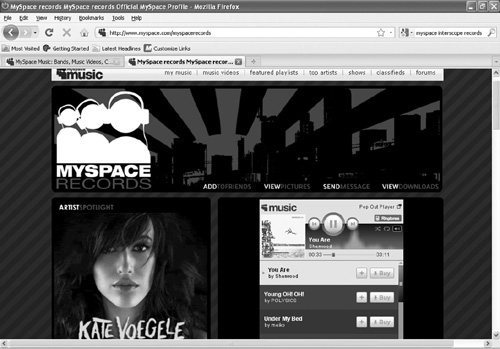
Figure 13.9. Kate Voegele, shown here on the MySpace Records page, is one of several successful independent artists who emerged from MySpace.com.
But what goes up must come down, as they say. Once the darling of online social sites, MySpace has lost favor and market share to others, such as Facebook. Once upon a time you had to have a MySpace page. Now you have to have a Facebook page.
The one huge exception to this is MySpace Music. The management at MySpace realized that they could leverage their huge population of music makers and music lovers into nothing less than their own label, which they formed in 2005 as a joint venture with Interscope Records. Today, MySpace has positioned itself as a social networking site that specializes or focuses on music, with its own label, MySpace Records.
MySpace Records is the label. However, label aside, there is a Music page on MySpace at www.music.myspace.com, shown in Figure 13.10. The Music page includes Music Videos, music video Charts, News, Shows & Events, Playlists, Artist’s Activity, and a whole lot more. Music playlists can be selected from categories such as Major, Indie, Unsigned, or Recently added by Friends.

Figure 13.10. Not to be confused with MySpace Records, the record label, is the music page on MySpace, known as MySpace Music.
There is also a Music Video page that features staff picks, hot videos, and recent videos (categorized by artists your friends are watching and artists you’re watching). Figure 13.11 shows the MySpace Video page with a video of Beyonce currently playing.
So, what you might be wondering is how you can be featured on MySpace Music (and ultimately, how you can get your music video featured on the Music Video page).
Well, if you mean the label, MySpace Music, you would have been noticed by now and signed a contract with MySpace/Interscope. But as an artist, how do you get featured on the MySpace Music page? Unfortunately, it’s not up to you. The answer is not unlike the method of climbing up the “charts” at YouTube—you have to have traffic, tons of traffic, coming to your own MySpace page. Then you get noticed (by MySpace staff). If you have enough “buzz” about you or the band, you may hear from a MySpace staffer.
What applies to music applies to music videos. You need to build up enough traffic to your own page before you can become a featured artist or have a highly visible music video on MySpace. But in the meantime, you need to get your music video on your main page and use every tool you can to build traffic. This means not only having your music video easily visible on your page (I’ve got my videos visible right on my main page as shown in Figure 13.12), but also using every method you can to build awareness. The tasks are the ones I’ve been discussing—post your music and your music videos, create a blog, and “friend” people (yes, friend is a verb now, as is unfriend). Post your touring schedule or appearances, get involved in groups, and use the bulletin board to make announcements that go out to your list of friends.
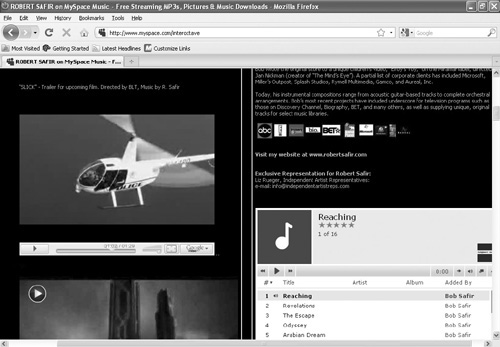
Figure 13.12. Make sure your own video is easily accessible on your main MySpace page, as illustrated here on my MySpace page.
Finally, network (or friend) with the type of people you would want to hang out with or get to know on a professional level. Those people might be your peers—other artists or bands. They might also be the managers, agents, or independent labels you would like to work with. But here’s a word of caution—don’t throw yourself at your music business connections and plead with them to visit your page. Such behavior comes off as desperate. It ignores the fact that these particular contacts also have a life, and probably a very busy one. Sure, you want them to visit your page. But use other methods, such as social skills (even if they are actually online social skills) to get people interested enough to hear your music and see your music video.
One of the coolest new features of MySpace is the Artist Dashboard. This dashboard provides you with statistics on your page views, the total songs played, the songs played today, other song statistics including trends, and the demographics of your audience. A summary of your dashboard appears on the page in which you manage your profile, as shown in Figure 13.13. Clicking View All Stats in the lower-right corner brings you to the complete dashboard page, shown in Figure 13.14.
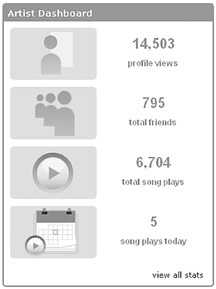
Figure 13.13. The summary of the Artist Dashboard appears when you manage your main page after signing in.
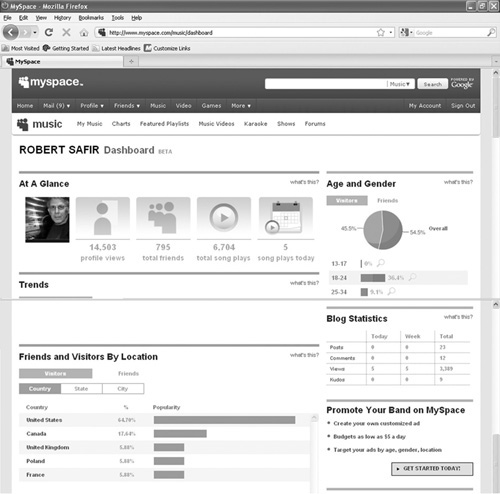
Figure 13.14. Clicking on View All Stats on the Artist Dashboard summary brings you to this page, loaded with statistics that can be useful in understanding your audience.
The Artist Dashboard comes complete with charts and graphs, and it’s free. This is the equivalent of having an analyst (not a shrink, but a number cruncher) on your personal payroll. Use these statistics to understand who your audience is, what tracks they like, and what these numbers and charts show about trends relative to your music. You might consider these facts before you choose which song to transform into a music video; and if you’ve already done that, consider the Artist Dashboard as a resource for determining what video to make next time.
For MySpace to work for you, you must be involved and active with it. If you do that, you can increase your traffic. If you increase your traffic, you increase the likelihood that your music video will be seen, and that your career just might take off.
Facebook’s rapid rise in popularity has led it to a position no one could have predicted in the early days of MySpace domination. Facebook is now the “Hertz Cars” of the social networking sites, whereas MySpace has become the “Avis” of the bunch. Translated into plain English, in case you haven’t seen a lot of television commercials for Hertz or Avis, Facebook is now number one, whereas MySpace is number two.
One of the main features of Facebook is the Wall, where you and your Facebook friends can post messages for others to see. You also can upload photos, share information via News Feed, update your Status, and gently Poke a friend who usually Pokes you in kind. You can join networks, form groups, and search for and add new friends to your heart’s content. These are all features you can access and change via your Home Page or Profile Page. See my Profile Page in Figure 13.15 (as you can see in the figure, Facebook Pages tend to be text-oriented and not as graphic as some social sites).
Facebook also lets you upload videos. Your video is compressed and converted into a Flash file that plays right on your Profile Page. This is one way to put your music video out there, but it’s not the only way.
What may be of more importance to you as an artist and music video producer is the Facebook feature known as Pages. Pages allow Facebook members to become a fan of a product, a service, or an individual. (Herbie Hancock has a Page as a professional artist, shown in Figure 13.16.) You might think of a Facebook Page as a commercial version of a regular Facebook account. And speaking of commercial, if you have a Page, you are also able to advertise, using pay-per-click or pay-per-impression advertising rates. As an advertiser, you get access to real-time reporting and other statistical results related to your ad.
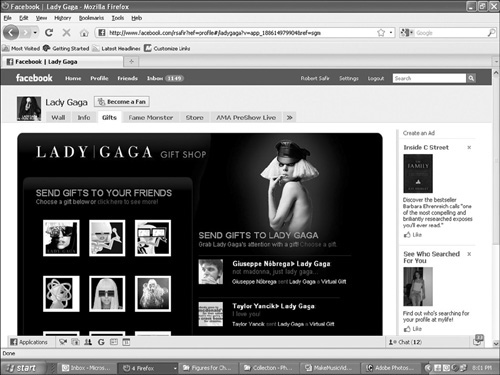
Although it is possible to upload videos to a regular Facebook account and to upload music-only tracks using several third-party apps available through Facebook, the Pages option allows more professional-looking results. You will find Pages from some of the music industry’s most popular artists on Facebook Pages.
Using Facebook Pages does not require you to participate in online advertising. The basic concept of Pages and fans helps to spread your message virally. When a fan interacts with your Page, stories linking to your Page can be directed via News Feed to their friends. When these friends interact with your Page, the News Feed keeps spreading the word, via word-of-mouth, to a wider network of friends.
You can do many things on a Facebook Page that you cannot do on a regular Profile Page. Figure 13.17 shows how you can Browse or Search for a specific artists. (You can see how the “King of Pop” appears at the very top of the list.) Figure 13.18 shows U2’s Video section selected from its artist Page. A professional Page enables you to host numerous videos from a central location as opposed to scattered videos showing up on a Wall or Newsfeed on a “regular” Page.
You also have the capability to send out messages to fans by clicking Send Update to Friends. This can be any kind of announcement, sales promotion, or news of an upcoming concert or event.
Facebook is in a very good position in the social-marketing landscape. How all of the competition in this landscape plays out remains to be seen. From your perspective, as an artist and music video maker, you need to keep on top of the fast-moving developments that occur in social media marketing. There are always two fronts to keep track of: the social media sites available to the public and the sites (social or not) that are focused on the music business. Those are your playgrounds.
“Twitter and tweets” sounds like something from a Warner Brothers cartoon, but it’s no joking matter. Twitter is a social-marketing tool that enables you to send and receive short (up to 140 characters) messages known as tweets. These messages can travel by a number of means, including the Twitter website, email, text messaging, and instant messaging. Tweets started out as simple updates on what you were doing at any given moment, such as “just combed hair, listening to Mariah C. on the 405 south.” (Within this message are a couple of potential social problems —combing one’s hair while driving is one of them, as is sending a text message while on the freeway. But that’s another topic altogether.) There are a few million tweets posted every day by over a million users. Figure 13.19 shows just a few tweets from a moment in time.
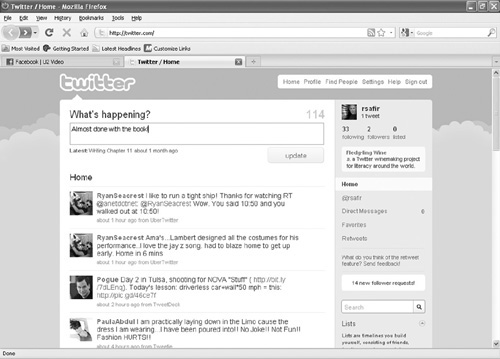
Figure 13.19. With Twitter, you can follow updates on what people are doing—and they can follow you.
Although tweets began life as simple messages about a person’s status, it wasn’t long before people realized that they could use it for more commercial purposes, such as sharing information about their products or services. Short electronic messages of any kind are sometimes grouped under the heading of “microblogs” or status updates (which is also one of the features on MySpace or Facebook).
Twitter is no longer considered a simple, personal message service for the under-30 crowd. It has grown to be used in a vast number of ways, including the following:
Promotion
Advertising
Surveys
Emergencies
Political campaigns
News
Twitter was even used as a communication platform during a Shuttle mission to service the Hubble Telescope.
Many people question and debate the viability of Twitter for any purpose beyond casual conversation. Can Twitter really be used as a marketing tool? You can, in fact, use tweets to:
Send out updates about your band.
Promote special offers such as CDs on sale.
Link to news pages (or for that matter, any page) on your own website.
Create buzz.
Reinforce your brand as an artist or band.
If you decide to use Twitter, make sure you get familiar with Twitter etiquette and the proper format for creating tweets. In general, it’s a good idea to keep the tone informal, conversational, and personal. This is not your father’s advertising vehicle. Try to be less “in-your-face” and more “hey, check this out.”
The Internet has given you an easy way to spread your message, above and beyond a specific site in which you choose to participate. Now, in the form of buttons, badges, or plain old links, you can be an electronic Johnny Appleseed. You do this in the form of placing these badges everywhere in which you have a presence, such as “Visit us on Facebook” (or MySpace or YouTube Channel, and so on). An example of these buttons can be seen in Figure 13.20.
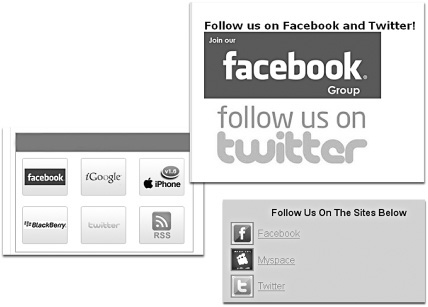
Figure 13.20. Everyone can find everyone else with badges or buttons. You can find them, visit them, and follow them. Just try not to annoy them.
It’s the easiest, quickest form of cross-marketing ever developed. Use it wisely and frequently.
I wanted to briefly mention LinkedIn, which is more of a business-oriented social networking site. It allows you to establish a link of contacts or connections, which through the laws of mathematics, continue over time to expand your network of additional contacts. LinkedIn can be used to make contact with people you wouldn’t ordinarily be able to reach (in the boring, mundane physical world) and can even be used to find or announce information about jobs or business opportunities.
LinkedIn also features groups. Anyone can form these groups, and just about anyone can join one, the main requirement being that you are actually a member of a certain community or discipline. There is a place in which you can provide answers to questions posed by other LinkedIn members, which is an opportunity to show your expertise in a particular subject. You can drive members to your own blog, and you can link to your own website.
LinkedIn may not be the ideal place for an up-and-coming band or artist, at least in terms of building a fan base. However, as a business-oriented site, you may find it useful in other ways, such as connecting with agents, managers, publicists, record labels, and so on. You will also find ways to connect to colleagues—other artists, songwriters, and musicians. Think of LinkedIn as social network for the business aspects of your career, and the other social sites I discussed as social-marketing sites to connect you with and build up your fan base.
A variety of marketing methods can be viewed as a part of both traditional and social media. They are as follows (in no particular order):
Email blasts: Sending emails to a list has origins in the corporate world. You can use email blasts to promote events to your fans or news to the music industry. I’d just advise you not to overdo this method and to give people an opportunity to opt out of receiving your messages.
Links to and from other sites: You may find sites where you’d like to have some sort of presence. Perhaps the site would be interested in having a presence on your website. Trading links is the way to accomplish this, which you do by identifying the best contact on the site you’re interested in and suggesting cross-linking. If it becomes a done deal, the links can be in the form of a URL or a button, a banner, or even a photo or video.
Trading banner ads: As in the preceding case, an appropriate or relevant trade of banner ads might be a possibility. It’s a lot cheaper than having to purchase a banner ad. Keep in mind though that the once glorious world of banner advertising is not as attractive or welcomed as it once was.
Optimized search: Learn what you need to do to include important keywords about you or your band so that you will come up often in search engine results. There is both a science and an art to this, and search engine optimization (SEO) is the subject of many books and articles.
Landing pages: These are pages that you specifically build on your own website, usually to measure the results of a particular marketing campaign. Say, for example, that you are giving free T-shirts away to the first 25 fans who respond to a contest question. The question may be located on your homepage or anywhere on the Internet. The thing to do is to have respondents go to a specific URL or landing page on your site where you can measure the number of respondents to this promotion.
Contests, promotions, and give-aways: These are fairly self-explanatory. But as with landing pages, make sure you have a way to measure the results. Otherwise, you won’t know where to put your time and energy to promote yourself.
Web analytics: Measuring traffic on your landing page is one thing, but analyzing traffic on your site—from where people enter the site to which pages they usually migrate to—can tell you a lot about the overall effectiveness of your web design. Google provides some tools for this for free, and several software companies make applications specifically designed for this purpose.
Internet forums: Participating in Internet forums is another way to have a presence and to get additional insight as to what other people (including fans) are thinking. You can have a forum of your own making as well as participate in relevant forums that already exist.
In the beginning of this chapter, I discussed two different schools of thought—traditional marketing and social marketing, with ardent believers on each end of the spectrum. Today, there is no shortage of blogs on which one is better than the other.
Many people refer to social marketing as relationship marketing. Perhaps social marketing, with an emphasis on relationships, has been the missing ingredient in traditional marketing. Or, just to make your head buzz, maybe it is traditional marketing that has been missing from social marketing. People will continue to debate the effectiveness of traditional marketing and social-media marketing. As I have stated, I believe a blend of both approaches works best. Your mileage may vary, but keep an open mind when you begin your marketing efforts and see where that takes you. Usually surprises are in store.
If you’d like a fool-proof method of marketing your music video on the Internet, you may have to look elsewhere—and you may have to look for a long, long time. None of the methods discussed here are guarantees of anything. Nor is there an absolute formula for which marketing methods, and in what combination, you should use. A lot of it comes from trial and error. But if your experimentation is built on some basic knowledge of marketing techniques—old school and new school—your chances of success are greatly increased.
When you stop and think about it, creating a music video—from beginning to end—and marketing it by using the Internet—has to be one of the most creative endeavors in which you can engage. A tremendous amount of creativity is necessary in every aspect of this process—creating the music, visualizing the story, producing the video, and creating and executing a marketing strategy. You can act on your imagination to take your ideas further with less cost than ever before, due in great part to the advances in technology that we enjoy today.
A tremendous amount of learning takes place during this process. Even if your effort doesn’t produce ultimate success your first time out, the experience of creating and marketing your music video will benefit you the next time and the next time after that.
As a maker of music videos, you practice many disciplines and are “many people,” all rolled into one. You are a songwriter. You are a film director. You are a marketing director. You are an entrepreneur.
You are a producer and a consumer—the ultimate prosumer—engaged in an exciting and tremendously creative endeavor.
Learning to make music videos is a combination of knowledge and experience, with a heavy emphasis on the latter. I often read about filmmakers who began using 8mm or 16mm film as a child and making their first movies when they could barely hold the camera. My choice was Super-8. Even back then, I used a primitive splicing block and something resembling Scotch Tape for my first attempts at film editing.
So I say, if you are not sure whether to make a music video based upon some wild idea spinning around in your head—make it.
If you’re not sure whether to make a music video based upon a song you have sitting on the shelf—make it.
If you’re not sure whether you should make an effort in music video-making because you might fail at it—make it. Make it anyway. Mistakes will be the lessons you can apply next time, and success may be just one of many more music video productions to come. Either way, you will have a lot of fun.
Enjoy.


